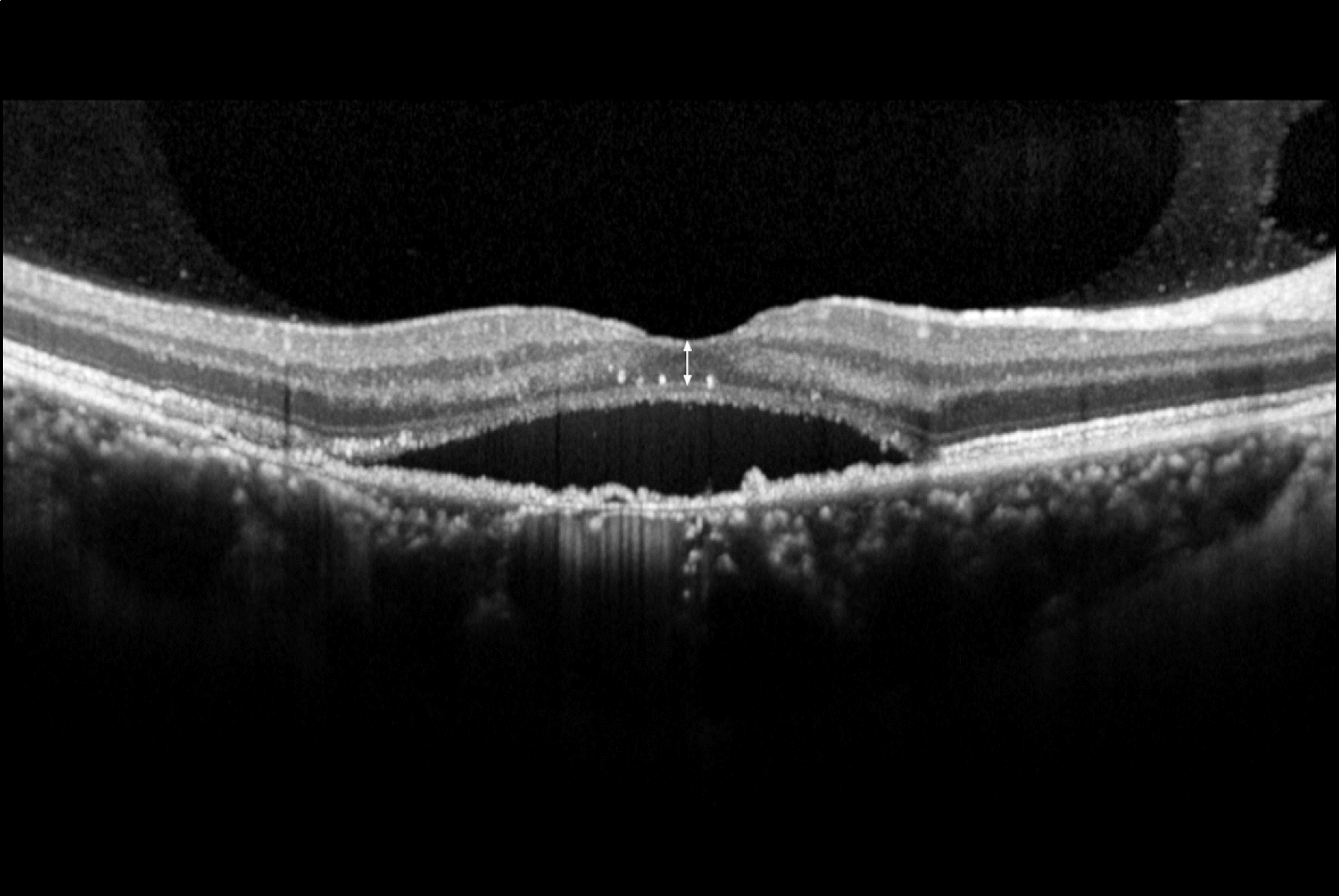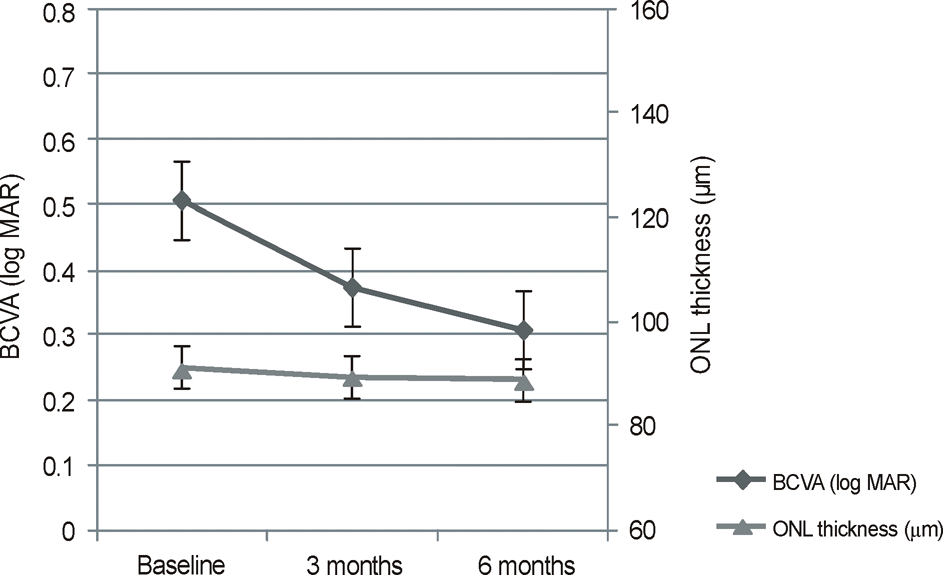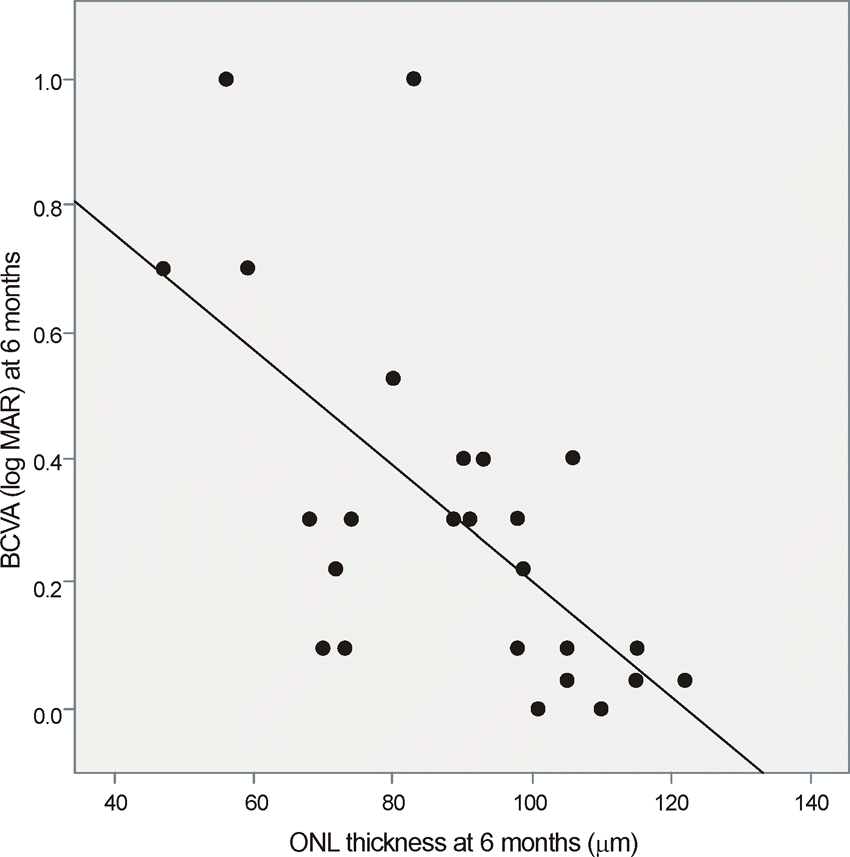Abstract
Purpose
To evaluate the results of half-dose photodynamic therapy (PDT) and determine the correlation between morphological changes measured by spectral-domain optical coherence tomography (SD-OCT) and visual acuity in patients with chronic central serous chorioretinopathy (CSC).
Methods
Twenty-five eyes of 25 patients with chronic CSC who had received half-dose verteporfin PDT were enrolled in the present study. The best-corrected visual acuity (BCVA), outer nuclear layer (ONL) thickness, and the integrity of the photoreceptor inner and outer segment junction (IS/OS) using SD-OCT were evaluated at baseline and at 3 and 6 months after treatment.
Results
The neurosensory retinal detachment disappeared in all eyes 6 months after treatment. The BCVA improved significantly from 0.50 ± 0.32 to 0.31 ± 0.29 log MAR at 6 months (p < 0.001). The average ONL thickness at the central fovea was 88.76 ± 19.95 μm at 6 months and the ONL thickness was well correlated with the BCVA (γ = −0.64; p = 0.001). There was no significant correlation between the status of IS/OS and the BCVA.
References
1. Gass JD. Pathogenesis of disciform detachment of the neuroepithelium. Am J Ophthalmol. 1967; 63:1–139.
2. Yap EY, Robertson DM. The long-term outcome of central serous chorioretinopathy. Arch Ophthalmol. 1996; 114:689–92.

3. Wang MS, Sander B, Larsen M. Retinal atrophy in idiopathic cen- tral serous chorioretinopathy. Am J Ophthalmol. 2002; 133:787–93.
4. Loo RH, Scott IU, Flynn HW Jr, et al. Factors associated with re- duced visual acuity during long-term follow-up of patients with idiopathic central serous chorioretinopathy. Retina. 2002; 22:19–24.
5. Robertson DM. Argon laser photocoagulation treatment in central serous chorioretinopathy. Ophthalmology. 1986; 93:972–4.

6. Piccolino FC. Laser treatment of eccentric leaks in central serous chorioretinopathy resulting in disappearance of untreated juxtafo- veal leaks. Retina. 1992; 12:96–102.
7. Colucciello M. Choroidal neovascularization complicating photo- dynamic therapy for central serous retinopathy. Retina. 2006; 26:239–42.
8. Tzekov R, Lin T, Zhang KM, et al. Ocular changes after photo-dynamic therapy. Invest Ophthalmol Vis Sci. 2006; 47:377–85.

9. Lai TY, Chan WM, Lam DS. Transient reduction in retinal function revealed by multifocal electroretinogram after photodynamic therapy. Am J Ophthalmol. 2004; 137:826–33.

10. Kim JL, Kim HW, Yoon IH. Photodynamic therapy with vertepofin for short time for chronic central serous chorioretinopathy. J Korean Ophthalmol Soc. 2008; 49:1078–86.

11. Chang MH, Kim SW, Oh JR, Huh K. Photodynamic therapy with verteporfin using half fluence for chronic central serous chorioretinopathy. J Korean Ophthalmol Soc. 2009; 50:1326–33.

12. Rouvas A, Stavrakas P, Theodossiadis PG, et al. Long-term results of half-fluence photodynamic therapy for chronic central serous chorioretinopathy. Eur J Ophthalmol. 2012; 22:417–22.

13. Smretschnig E, Ansari-Shahrezaei S, Moussa S, et al. Half-fluence photodynamic therapy in acute central serous chorioretinopathy. Retina. 2012; 32:2014–9.

14. Bressler NM. Treatment of age-related macular degeneration with photodynamic therapy (TAP) Study Group. Photodynamic therapy of subfoveal choroidal neovascularization in age-related macular degeneration with verteporfin: one-year results of 2 randomized clinical trials-TAP report 1. Arch Ophthalmol. 1999; 117:1329–45.
15. Bressler NM. Treatment of age-related macular degeneration with photodynamic therapy (TAP) Study Group. Photodynamic therapy of subfoveal choroidal neovascularization in age-related macular degeneration with verteporfin: two-year results of 2 randomized clinical trials - TAP report 2. Arch Ophthalmol. 2001; 119:198–207.
16. Piccolino FC, Eandi CM, Ventre L, et al. Photodynamic therapy for chronic central serous chorioretinopathy. Retina. 2003; 23:752–63.

17. Yannuzzi LA, Slakter JS, Gross NE, et al. Indocyanine green an- giography-guided photodynamic therapy for treatment of chronic central serous chorioretinopathy: a pilot study. Retina. 2003; 23:288–98.
18. Taban M, Boyer DS, Thomas EL, et al. Chronic central serous cho- rioretinopathy: photodynamic therapy. Am J Ophthalmol. 2004; 137:1073–80.
19. Uetani R, Ito Y, Oiwa K, et al. Half-dose vs one-third-dose photo- dynamic therapy for chronic central serous chorioretinopathy. Eye. 2012; 26:640–9.
20. Fujita K, Shinoda K, Imamura Y, et al. Correlation of integrity of cone outer segment tips line with retinal sensitivity after half-dose photodynamic therapy for chronic central serous chorioretinopathy. Am J Ophthalmol. 2012; 154:579–85.

21. Matsumoto H, Sato T, Kishi S. Outer nuclear layer thickness at the fovea determines visual outcomes in resolved central serous chorioretinopathy. Am J Ophthalmol. 2009; 148:105–10e1.

22. Hata M, Oishi A, Shimozono M, et al. Early changes in foveal thickness in eyes with central serous chorioretinopathy. Retina. 2013; 33:296–301.

23. Iida T, Yannuzzi LA, Spaide RF, et al. Cystoid macular degener- ation in chronic central serous chorioretinopathy. Retina. 2003; 23:1–7.
24. Eandi CM, Chung JE, Cardillo-Piccolino F, et al. Optical coher- ence tomography in unilateral resolved central serous choriore- tinopathy. Retina. 2005; 25:417–21.
25. Matsumoto H, Kishi S, Otani T, et al. Elongation of photoreceptor outer segment in central serous chorioretinopathy. Am J Ophthalmol. 2008; 145:162–8e1.

26. Ojima Y, Tsujikawa A, Yamashiro K, et al. Restoration of outer segments of foveal photoreceptors after resolution of central se- rous chorioretinopathy. Jpn J Ophthalmol. 2010; 54:55–60.
Figure 1.
Representative image of 53-year-old female patient with central serous chorioretinopathy. Perpendicular line was drawn from the internal limiting membrane to the external limiting membrane at the central fovea, and outer nuclear layer thickness was measured using the computer-based caliper tool in the spectral-domain optical coherence tomography.

Figure 2.
Representative pattern of the photoreceptor inner and outer segment junction (IS/OS) obtained by spectral-do- main optical coherence tomography in eyes with chronic central serous chorioretinopathy. (A) IS/OS line is nearly continuous and intact. (B) IS/OS line is fragmented and partially disrupted. (C) IS/OS line is absent.

Figure 3.
Temporal changes of best-corrected visual acuity (BCVA) and outer nuclear layer (ONL) thickness after half-dose photodynamic therapy in patients with chronic central serous chorioretinopathy. Error bars represent standard errors of the mean. By 3 month, the mean BCVA was significantly improved from 0.50 to 0.37 log MAR (p = 0.007). There was no significant difference in BCVA between 3 and 6 months (p = 0.54). The average ONL thickness at 6 months was 88.76 ± 19.95 μm and no significant difference in ONL thickness was noted at all time points (p > 0.05, Wilcoxon signed rank test).

Figure 4.
Graph showing the outer nucler layer (ONL) thickness at the central fovea in 25 patients with chronic central serous chorioretinopathy treated with half-dose photodynamic therapy compared with their best-corrected visual acuity (BCVA). The ONL thickness at 6 months is negatively correlated with log MAR BCVA at 6 months (Spearman's correlation coefficient γ = −0.642, p= 0.001).

Figure 5.
Fluorescein angiograph (FA) and spectral-domain optical coherence tomography (SD-OCT) images in a 58-year-old man with chronic central serous chorioretinopathy. (A, B) FA shows a characteristic leakage at the central macula in early and late phase. (C) Serous retinal detachment with irregular, thickened photoreceptor inner and outer segment junction (IS/OS) is noted at baseline. (D) The SD-OCT at 6 months after treatment shows complete resolution of the subretinal fluid and restoration of IS/OS. The outer nuclear thickness was measured as 47 μm. The best-corrected visual acuity was 0.52 log MAR with no improvement.

Figure 6.
Fluorescein angiograph (FA) and spectral-domain optical coherence tomography (SD-OCT) images in a 56-year-old woman with chronic central serous chorioretinopathy. (A, B) FA shows some leakage at the nasal macula in early and late phase. (C) Serous retinal detachment with elongation of outer segment is noted at baseline. (D) The SD-OCT at 6 months after treatment shows nearly complete resolution of the subretinal fluid and partial irregular photoreceptor inner and outer segment junction. The outer nuclear thickness was measured as 100 μm. The best-corrected visual acuity improved from 0.40 to 0.09 log MAR.

Table 1.
Demographic characteristics of the patients
Table 2.
Status of photoreceptor inner and outer segment junction (IS/OS) at baseline and after half-dose photodynamic therapy in 25 patients with chronic central serous chorioretinopathy
| Baseline | 3 months | 6 months | |
|---|---|---|---|
| IS/OS + | 7 (28%) | 15 (60%) | 16 (64%) |
| IS/OS ± | 2 (8%) | 5 (20%) | 5 (20%) |
| IS/OS- | 16 (64%) | 5 (20%) | 4 (16%) |




 PDF
PDF ePub
ePub Citation
Citation Print
Print


 XML Download
XML Download